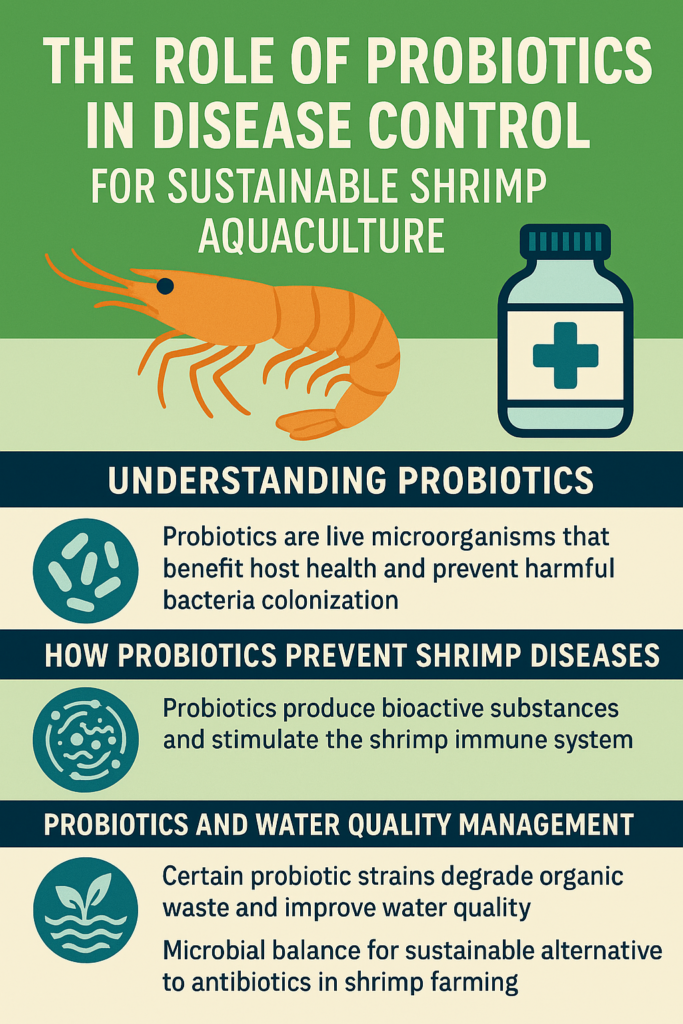Shrimp aquaculture is one of the fastest-growing sectors of global aquaculture, contributing significantly to economic growth and food security. However, intensification of shrimp farming systems to meet rising global demand has also increased the risk of devastating disease outbreaks. Pathogens such as Vibrio spp., Early Mortality Syndrome (EMS), and White Spot Syndrome Virus (WSSV) have caused massive losses for farmers worldwide.
In recent years, probiotics have emerged as a safe, eco-friendly, and effective alternative to antibiotics and harmful chemicals for disease prevention in shrimp farming.
The Role of Probiotics in Disease Control for Sustainable Shrimp Aquaculture
Probiotics are live microorganisms that benefit the host when administered in adequate amounts. In shrimp aquaculture, they work by:
- Strengthening the immune system
- Preventing harmful bacteria colonization
- Balancing gut microflora
Unlike antibiotics, which kill both beneficial and harmful microbes, probiotics selectively support beneficial microbial communities that naturally suppress pathogens through competitive exclusion. This means they outcompete harmful bacteria for nutrients and attachment sites in the shrimp’s digestive tract.
How Probiotics Prevent Shrimp Diseases
Probiotics combat disease in several ways:
- Production of Bioactive Substances – Certain probiotics produce bacteriocins, organic acids, and enzymes that directly inhibit pathogens. For example, lactic acid bacteria reduce gut pH, creating an environment hostile to harmful microorganisms.
- Immune System Stimulation – Probiotics enhance shrimp immunity by increasing antimicrobial peptide production and activating hemocytes, which are essential in defending against bacterial, fungal, and viral infections.
- Improved Digestion and Growth – Probiotics increase digestive enzyme production, improving feed efficiency, growth rate, and disease resistance.

Probiotics and Water Quality Management
Maintaining good pond water quality is vital in shrimp aquaculture. Certain probiotic strains, such as Bacillus species, degrade organic waste, reducing ammonia and nitrite levels. This improves water quality, lowers stress, and decreases disease susceptibility.
Microbial Balance for Sustainable Shrimp Aquaculture
By combining microbial balance, competitive exclusion, immune stimulation, and water quality improvement, probiotics offer a holistic approach to disease prevention. They represent a sustainable alternative to antibiotics—supporting healthier shrimp, reducing losses, and ensuring the long-term viability of shrimp farming.
However, correct probiotic strain selection, dosage, and application method are key to achieving the best results. Continued research and training are essential for maximizing benefits.
Start Your Shrimp Aquaculture Journey Today
Are you ready to venture into sustainable shrimp aquaculture? The Ecolonomics Action Team provides valuable resources, expert guidance, and networking opportunities with experienced shrimp farmers.
Join the EAT Community today and gain the knowledge and support you need to succeed in eco-friendly shrimp production.
References & Related Articles:
- Freshwater Shrimp Aquaculture Techniques to Adopt
- FAO. (2016). The Use of Probiotics in Aquaculture. Read here
- Verschuere, L., et al. (2000). Probiotic bacteria as biological control agents in aquaculture. Microbiology and Molecular Biology Reviews, 64(4), 655–671.
- De Schryver, P., et al. (2012). Probiotics in aquaculture: A review. Aquaculture, 356–357, 1–14.




